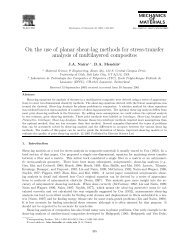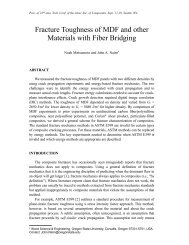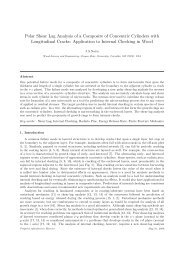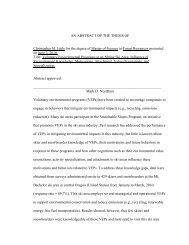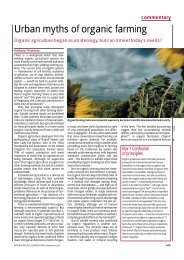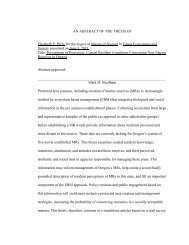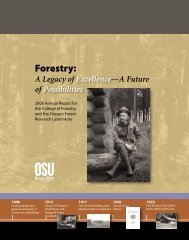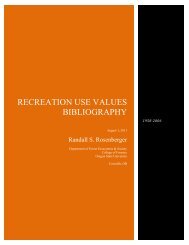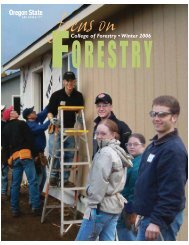Planting a Legacy Rick Strachan '78 - College of Forestry - Oregon ...
Planting a Legacy Rick Strachan '78 - College of Forestry - Oregon ...
Planting a Legacy Rick Strachan '78 - College of Forestry - Oregon ...
- No tags were found...
You also want an ePaper? Increase the reach of your titles
YUMPU automatically turns print PDFs into web optimized ePapers that Google loves.
ange <strong>of</strong> fire-related factors: wildlife, naturalregeneration, soil, fire severity and pre-fireconditions, including past salvage logging.These and other studies will help to fillcritical information gaps. A 2001 ForestService review found only 21 studies worldwideon the environmental effects <strong>of</strong> postfirelogging. Only 14 compared loggedareas to unlogged controls.Nevertheless, dead and living trees havelong been harvested after fires. And relyingon both natural regeneration and planting,foresters have traditionally sought to spurtree growth as quickly as possible, saysDavid Hibbs, OSU pr<strong>of</strong>essor <strong>of</strong> ForestScience and coordinator <strong>of</strong> OSU’sCooperative Forest Ecosystem ResearchProgram. As a result, forest managers have arich bank <strong>of</strong> practical experience in reachingthat goal. For their part, researchersfocused on barriers to plant growth, theproductivity <strong>of</strong> plant communities andforest succession over decades. One example:the <strong>College</strong> <strong>of</strong> <strong>Forestry</strong>’s <strong>Forestry</strong>Intensive Research program, begun in 1980to evaluate reforestation options on shrubdominatedsites in southwest <strong>Oregon</strong>.In recent years, a shift in social valueshas led to a change in science. Hibbs notesthat the view <strong>of</strong> fire as destruction hasbroadened to include a focus on the ecologicalfactors that support forest regeneration.This view recognizes that fire is part <strong>of</strong> anatural system that sets the stage for anentire ecosystem.The shift is important because it impliesa changing response to fire. To some, practicessuch as ground-based salvage loggingare generally inconsistent with naturalecosystem restoration. On the other hand,forest managers maintain that quick actionsuch as logging, tree planting and evendisposal <strong>of</strong> logging debris can spur treegrowth in places dedicated to timber“In a more open landscape,fires typically stayed lowand large trees survived.Now when fires occur, they<strong>of</strong>ten kill everything. There’sno habitat left.”David Hibbs,Pr<strong>of</strong>essor, Forest Scienceproduction. Such practices are expensive,and logging provides a source <strong>of</strong> revenue tohelp <strong>of</strong>fset the costs.The need to resolve the debate bringssome urgency. A century <strong>of</strong> fire suppressionhas led to dramatic changes, especially in dryforests, adds Hibbs. Trees occupy formergrasslands, and forests that had an open<strong>College</strong> Newsunderstory have become dense. This thickergrowth may benefit spotted owls and otherforest dwellers, but the additional wood alsoprovides the fuel for more intense fires.“In a more open landscape, fires typicallystayed low and large trees survived. Nowwhen fires occur, they <strong>of</strong>ten kill everything.There’s no habitat left,” says Hibbs.Moreover, a return to historical fire regimesis not possible. “We’re in a whole new ballgame,”he adds.Ongoing studies receive funding fromsources that include the Forest Service, theBureau <strong>of</strong> Land Management and otherfederal agencies operating through the JointFire Science Program. They could helpanswer a variety <strong>of</strong> questions about post-firemanagement on a site-by-site basis: howmany, if any, trees to cut; what harvestingtechniques to use; whether and how tocontrol competing vegetation; what, whenand where to replant. These studies willimprove the scientific basis for a range <strong>of</strong>management options, providing guidance t<strong>of</strong>orest managers and researchers.Learn more about projects underway inthe Cooperative Forest Ecosystem Researchprogram at fsl.orst.edu/cfer/Reprinted from Terra: A World <strong>of</strong> Research andCreativity at <strong>Oregon</strong> State University, Vol. 1, No.2,Summer, 2006 (oregonstate.edu/terra)Vegetation and wildlifeContinuing their study <strong>of</strong> salvage logging,plant and tree growth, wildlife and fire risk arethe team that produced the Science paper. Ledby OSU Forest Science Pr<strong>of</strong>essor Beverly Law,the team includes Donato and John Campbellin Forest Science, Joe Fontaine and DougRobinson in Fisheries and Wildlife and BooneKauffman <strong>of</strong> the Forest Service. In particular,they are interested in the effects <strong>of</strong> re-burn.What are the consequences <strong>of</strong> a second highseverity fire within two decades <strong>of</strong> the first fire?Riparian zonesAreas along rivers and streams provide importantecological habitats and may respond to firein a different manner than surroundinguplands. Graduate student Jessica Hal<strong>of</strong>sky isworking with Hibbs to understand fire behaviorin riparian zones.ShrubsMost shrubs come back after fire from rootsprouts or the seed bank, but if they aredamaged or killed by logging operations, willthey recover? OSU graduate student MariaLopez and Hibbs will begin a study thissummer to answer that question. Shrubsprovide an important food source and coverfor wildlife, and some types <strong>of</strong> shrubs providenutrients to growing trees.Soil fungiSoil fungi play a crucial role in forest ecosystemsby recycling nutrients. Matt Trappe, aPh.D. student in the Environmental SciencesProgram, is studying the effects <strong>of</strong> prescribedburning on mycorrhizal fungi in an old-growthponderosa pine forest in Crater Lake NationalPark. Trappe is working with KermitCromack, OSU pr<strong>of</strong>essor emeritus, and JimTrappe and Efrén Cázares <strong>of</strong> the Department<strong>of</strong> Forest Science, to understand fungal activityafter fire.Fall 2006




